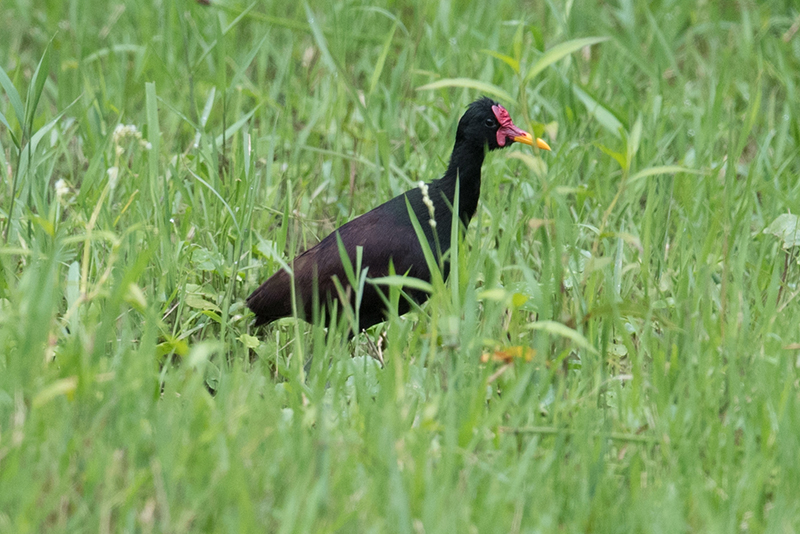WATTLED JACAna's has 50% mortality rate to reach adulthood
GALLITO DE CIENAGA: solo la mitad de Las crias sobreviven
Jacana jacana
The Wattled Jacana is a colorful water medium-sized bird with long bluish-grey legs and very long toes and claws. Its long toes allow it to walk across floating vegetation. It always has a red forehead and a wattle at base of bill. The adult has reddish or chestnut-brown upperparts. Head and neck are black. The yellow bill contrasts strongly with the red coloration. The eyes are dark brown. The male weighs from 88 to 120 g. Females are twice heavier than males. It uses its bill to turn over aquatic vegetation, grasslands, cultivated areas and wet meadows. It can grasp the edges of these plants with the toes to partially turn them over in search of food. Insects, snails, worms, small crabs, fish, mollusks, and seeds are all on the menu. The jacana often sends out noisy alarms when it thinks predators are near. If threatened, her chicks, as well as adults, stay underwater for long periods with only the tip of their bill above water. They can also swim underwater to avoid predators. These birds have a sharp spur on the elbow of each wing for defense. The female lays 3-4 eggs that are incubated up to 28 days. They are olive/tan-colored shiny and glossy. They have dark markings with a beautiful design that is different for each egg. Chicks can walk, swim, and dive a few hours after hatch. The male carries his chicks under his wings, if in danger. Only about half of all jacana chicks survive to adulthood.
Inconfundible gracias a combinación de patas y dedos muy largos, pico amarillo, y rémiges de color amarillo verdoso que se le ven al volar. Patas y dedos azul verdoso. Debido a sus dedos largos pueden caminar sobre vegetación acuática. Presenta pico amarillo con un peculiar escudo frontal bilobulado y carúnculas laterales de color rojo. Su cabeza, cuello y partes inferiores son negros. El centro de la espalda y gran parte del ala cerrada es de color castaño marrón. Posee un espolón carpiano de color amarillo. La hembra es un poco más grande que el macho y usualmente presenta un color azulado a lo largo del borde superior de sus carúnculas. Es un ave muy común en sitios húmedos con abundante vegetación flotante. Se le encuentra en ciénagas, lagunas, pantanos y ríos de corriente lenta. Vuela solo cortas distancias con rápidos aleteos y las patas levantadas mostrando sus alas amarillas. Se alimenta de insectos e invertebrados acuáticos, semillas y material vegetal. La jacana es poliándrica: la hembra se reproduce con varios machos. Construye un nido flotante pequeño en el cual pone 3-4 huevos color café oliva con estrías negras. Los huevos son incubados por 28 dias por el macho que se encarga del cuidado de las crías. Vuela solo cortas distancias con rápidos aleteos y las patas levantadas mostrando sus alas amarillas. Pueden sumergirse para defenderse. Solo la mitad de las crías sobreviven.

LAM_4157

LAM_4159
